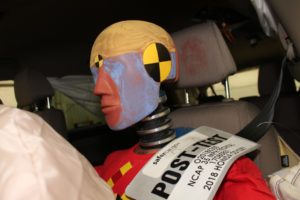
We’ve spent a lot of time over the years talking about safe and unsafe practices behind the wheel. There are obvious things not to do, like speeding, driving unbuckled, and drinking. However, there are less obvious factors that may play larger roles in day-to-day crashes, if not fatalities, than most of us realize, and one of them is drowsy driving. Driving while tired (as in too tired to drive safely) is, per a recent study by the AAA Foundation for Traffic Safety, a factor behind around 10% of crashes in the United States. Let’s dig into the article a bit and see what we can learn.
The NHTSA is underestimating drowsy driving risks and prevalence
Those 3,500 drivers were involved in more than 700 crashes. Drowsiness was determined to be a factor in up to 9.5 percent of those accidents. In addition, more than 10 percent of the accidents that resulted in property damage, airbag deployment or injury involved tired drivers.
The percentages are far higher than what the federal government has estimated as the impact of drowsy driving, which it puts at 1 to 2 percent of all vehicle crashes.

This is significant, because there’s a 5-10x discrepancy between the results of this study and previous estimates from the federal government (with the relevant agency here being the National Highway Traffic and Safety Administration, or NHTSA). I’ve written about NHTSA errors before, such as in their refusal to adopt stronger safety standards for rear-facing, for seat strength standards, for traffic speed enforcement, for semi trailer underride prevention, and for crash tests.
It’s a flawed industry, particularly compared to its NCAP equivalent in Europe. Now it appears they’re dramatically underestimating the significance of sleeping drivers on crash rates. If this is true, it’s easy to see why they’d devote less attention toward public education, law enforcement, and cultural change toward attitudes about sleepy driving. You can’t change what you don’t perceive to be a problem. But the stats suggest that this is a problem.
Around 3 out of every 10 drivers admit to practically falling asleep at the wheel every month
It also comes at a time when researchers in many fields are examining the impact of Americans failing to get enough sleep. A recent survey by the AAA foundation found 29 percent of those questioned admitted to driving, at some point in the past month, when they were so tired they had a hard time keeping their eyes open.

Are you scared yet? Because per the study, nearly 3 in 10 drivers admitted that in the last month, they’d driven at least once while so tired they could barely keep their eyes open. At that level of tiredness, you’re not paying attention to what’s in front of you, never mind to what’s beside you or behind you in your mirrors; you’re struggling to keep from falling asleep completely, and anyone who’s anywhere around you (never mind in the same vehicle as you) is risking their lives. The problem, of course, is that you can’t tell the driver approaching you in the opposite lane is falling asleep until s/he starts veering into yours. And if you’re not driving on an undivided road, your odds of surviving a head-on collision will drop rapidly above 43 mph. It happens over and over and over again.
Drowsy driving is drunk driving
“Missing just two to three hours of sleep can more than quadruple your risk for a crash, which is the equivalent of driving drunk,” said Jake Nelson, director of traffic safety advocacy and research at AAA.

This, as far as I’m concerned, is the keystone point of the article. When you drive while tired, dozing, sleepy, drowsy–whatever you call it–you’re effectively driving drunk. We’ve talked before about how there is no safe amount of alcohol you can drink before driving. I wouldn’t go as far as to say this exists for sleep, as the range of what constitutes “a good night’s sleep” varies more than the body’s inability to process alcohol, but using the baseline of 7.5 hours as a minimal amount of necessary sleep as suggested by Dan Beuttner in his excellent text on healthy living, The Blue Zones, Nelson’s quotation above suggests that dropping down to 5 hours of sleep places your body under the same handicaps as having a drink (or two, or three; it doesn’t matter) before getting behind the wheel.
Driving while sleepy is harder to detect, but it may claim thousands of lives a year

The difference, of course, is that a lack of sleep won’t show up in a blood or breathalyzer test. It’s also far more socially acceptable to drive while tired than it is to drive while drunk, even though drunk driving is still socially acceptable enough to factor into 30% of fatal crashes year after year. Right now, we really have no idea how many fatal crashes are due to people simply falling asleep or driving in sleepy states immediately before collisions. We know it happens sometimes; I’ve written about it multiple times, such as in the case where a young man fell asleep, crossed lanes, and killed a lady in her 50s. I wrote about it elsewhere in a case where a baby died on Christmas day while a family was driving and the father fell asleep.

There are many more stories I’ve covered through the years, and most likely thousands more that occur each year but that are classified as having to do with lapses of “attention.” Few people, after all, will readily admit to having fallen asleep behind the wheel upon realizing that their actions led to the death of another human being. And of course, if you fall asleep and die in a crash as a result, whether after crashing into another vehicle or simply by leaving the road (because remember, a full 50% of fatal crashes don’t involve any vehicles beyond the one carrying the driver), no one’s ever going to know you died because you didn’t get enough hours of sleep the previous night.
Take the time to get a good night’s sleep every night if at all possible, especially if there’s any chance of driving the following day. Much like a hangover, the only cure for a lack of sleep is time–in this case, time with your eyes closed. If you don’t make that time in bed, you’ll make it up behind the wheel, and potentially in the grave.
 If you find my information on best practices in car and car seat safety helpful, you can buy my books here or do your shopping through this Amazon link. Canadians can shop here for Canadian purchases. Have a question or want to discuss best practices? Send me an email at carcrashdetective [at] gmail [dot] com.
If you find my information on best practices in car and car seat safety helpful, you can buy my books here or do your shopping through this Amazon link. Canadians can shop here for Canadian purchases. Have a question or want to discuss best practices? Send me an email at carcrashdetective [at] gmail [dot] com.

